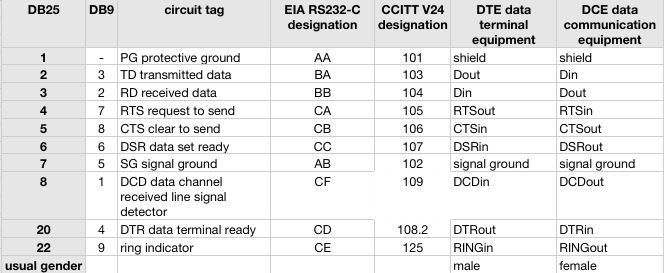RS232C / V.24 pin-out and signal directions
revision September 2016

There are two classes of device which we still call (for historical reasons) DTE and DCE. As you can see in the table, the designations of the various circuits are determined by there functionality with respect to Data Terminal Equipment. In fact the official EIA and CCITT designations are 'neutral', but these are hardly known today.
The actions of the various pins should always be consistent with either DTE or DCE. So, we wouldn't expect a device where pin 2 is Dout and pin 20 is DTRin!
Caution: In the table only the almost exclusively used pins 1-8 and 20 are shown (and 22 because it officially has a counterpart on the DB9 connector). Pins not explicitly mentioned, and also pin DB9/9 are often used for vendor-specific purposes, like current-loop or synchronous interfacing. It is therefore not advisable to use 25-conductor flat cables without making sure that no incompatible circuits are present on either side.
Examples of DTE are most alphanumeric and graphics terminals, plotters, and the IBM-PC. A USB-to-serial adapter (like FTDI US232R) plus appropriate driver provides a contemporary computer with a DTE interface.
DCE includes modems, serial mouses, graphics tablets.
Local connection of similar devices (either DTE or DCE) without wired handshaking:
| 1 | ------ | 1 |
| 2 | ------ | 3 |
| 3 | ------ | 2 |
| 4-5 | 4-5 | |
| 6-8-20 | 6-8-20 | |
| 7 | ------ | 7 |
Local connection of similar devices with basic wired handshaking:
| 1 | ------ | 1 |
| 2 | ------ | 3 |
| 3 | ------ | 2 |
| 5-6-8 | ------ | 20 |
| 20 | ------- | 5-6-8 |
| 7 | ------ | 7 |
Alternatively,
| 1 | ------ | 1 |
| 2 | ------ | 3 |
| 3 | ------ | 2 |
| 4 | ------ | 5 |
| 5 | ------ | 4 |
| 6-8 | ------ | 20 |
| 20 | ------ | 6-8 |
| 7 | ------ | 7 |
